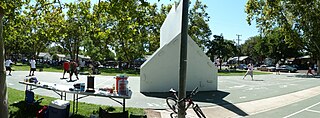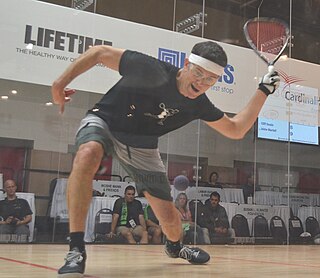Related Research Articles

Björn Rune Borg is a Swedish former world No. 1 tennis player. Between 1974 and 1981, he became the first man in the Open Era to win 11 Grand Slam singles titles with six at the French Open and five consecutively at Wimbledon.

Racquetball is a racquet sport and a team sport played with a hollow rubber ball on an indoor or outdoor court. Joseph Sobek invented the modern sport of racquetball in 1950, adding a stringed racquet to paddleball in order to increase velocity and control. Unlike most racquet sports, such as tennis and badminton, there is no net to hit the ball over, and, unlike squash, no tin to hit the ball above. Also, the court's walls, floor, and ceiling are legal playing surfaces, with the exception of court-specific designated hinders being out-of-bounds. Racquetball is played between various players on a team who try to bounce the ball with the racquet onto the ground so it hits the wall, so that an opposing team’s player cannot bounce it back to the wall.

James Scott Connors is an American former world No. 1 tennis player. He held the top Association of Tennis Professionals (ATP) ranking for a then-record 160 consecutive weeks from 1974 to 1977 and a career total of 268 weeks. By virtue of his long and prolific career, Connors still holds three prominent Open Era men's singles records: 109 titles, 1,557 matches played, and 1,274 match wins. His titles include eight major singles titles, three year-end championships, and 17 Grand Prix Super Series titles. In 1974, he became the second man in the Open Era to win three major titles in a calendar year, and was not permitted to participate in the fourth, the French Open. Connors finished year end number one in the ATP rankings from 1974 to 1978. In 1982, he won both Wimbledon and the US Open and was ATP Player of the Year and ITF World Champion. He retired in 1996 at the age of 43.

American handball, known as handball in the United States and sometimes referred to as wallball, is a sport in which players use their hands to hit a small, rubber ball against a wall such that their opponent(s) cannot do the same without the ball touching the ground twice nor hitting out-of-bound. The three versions are four-wall, three-wall and one-wall. Each version can be played either by two players (singles), three players (cutthroat) or four players (doubles), but in official tournaments, singles and doubles are the only versions played.

Ricardo Alonso "Pancho" González, known sometimes as Richard Gonzales, was an American tennis player. He won 15 major singles titles, including two U.S. National Singles Championships in 1948 and 1949, and 13 Professional Grand Slam titles. He also won three Tournament of Champions professional events in 1957, 1958, and 1959. He was ranked world amateur No. 1 in 1948 by Ned Potter and in 1949 by Potter and John Olliff. Gonzales was a prominent professional champion in the 1950s and 1960s, winning world professional championship tours between 1954 and 1961; he was ranked world No. 1 professional in some rankings between 1952 and 1961.

Rafael Osuna Herrera , nicknamed "El Pelón", was a former world No. 1 tennis player, the most successful player in the history of Mexico and an Olympian. He was born in Mexico City, and is best remembered for his singles victory at the U.S. Open Championships in 1963, winning the 1960 and 1963 Wimbledon Doubles championships, the 1962 U.S. Open Championships doubles, and for leading Mexico to its only Davis Cup Final round appearance in 1962. He is the only Mexican to date to be inducted into the International Tennis Hall of Fame, in 1979.

Prince Global Sports, LLC is an American sporting goods manufacturing company based in Atlanta, Georgia. Founded in 1970, Prince's range of products includes rackets, footwear, apparel, tennis balls, pickleball paddles, stringing machines, hats and bags.
Sudsy Monchik, is an American racquetball player. As a five-time Pro World Champion, Monchik is one of the top 3 players in the history of the sport. Monchik was known for his power and speed, as well as his shot-making ability, especially his backhand, which many believe is the best in the game. Sudsy revolutionized the sport with his electric personality combined with his tremendous shot power from both his backhand and forehand along with his jaw dropping shot making ability. Sudsy only competed professionally for 7 seasons. Due to a back condition and broken foot which needed surgery, he had to retire early. There are many that believe if he had been healthy he would have shattered all the records. Sudsy only played 7 healthy seasons on the professional tour and finished the season as the #1 player in the world an astonishing 5 times. Sudsy is the true ambassador to Racquetball worldwide. Sudsy made another outstanding comeback with a win in the 2018 USA Racquetball National Doubles Championships with partner Rocky Carson. Sudsy will now represent Team USA in San Jose, Costa Rica for the World Championships in August 2018. Sudsy's wife, Veronica Sotomayor is the most decorated racquetball player in the history of her home country of Ecuador.
For the sport called "beach paddleball", see Matkot. For other sports called "paddleball", see Paddleball (sport).
Franklin Wesley "Bud" Held is an American athlete primarily notable for his performance throwing the javelin. He was born in Los Angeles, California.
Marty Hogan is a former American racquetball player who won more than 100 international or national titles and six U.S. national championships during his 14-year career. Hogan was ranked either number one or number two in the world from 1976 to 1990.
Paul Haber (1937–2003) was an American one, three, and four wall National Handball champion. Haber is credited with being the first player to use the ceiling offensively and did so very effectively. He was inducted into the United States Handball Association Hall of Fame in 1983. Paul Haber was born of Polish Jewish ancestry in the Bronx in 1937. He won countless American and Canadian handball titles. Haber took an overlooked sport and turned it into a publicized one. Haber appeared on the front page of the Wall Street Journal in 1970. Numerous magazines featured him including Sports Illustrated, Ace, and Argosy. It was not just Haber's ability on the court that caught national media attention. Haber would clobber the straight arrow handball players and then wind up in jail or a hospital after days of being on a bender with various females. He supported himself giving handball and golf lessons, playing cards, pool, board games, and betting on his handball matches. Haber lived day-to-day forgetting each night's escapades and capers in anticipation of the next one. He lived a lifestyle that would have ruined most professional athletes.

Cliff Swain is a professional racquetball player and coach from Boston, Massachusetts. Known for his dominant drive serve and on-court intensity, Swain finished as the #1 player on the International Racquetball Tour (IRT) six times -- in 1990, 1993, 1994, 1995, 1998, and 2002. He won US Open Championships in 1997 and 2001, and was inducted into the USA Racquetball Hall of Fame in 2003. A legendary figure in racquetball for over 3 decades, Swain still plays professionally and is quickly becoming a sought-after professional coach as well.
Ektelon, Inc. is an American manufacturer of equipment for racquetball.
Charles Edgar Brumfield is an American attorney and former professional racquetball player as well as a noted paddleball player. For much of his professional racquetball career, Brumfield was the marquis player for Leach Industries, the leading manufacturer of racquetball rackets at the time. Leach produced several Brumfield signature rackets including the very popular "Graphite Brumfield". For a brief time, Brumfield had his own sports brand label, known as BrumStar, which marketed rackets and sports apparel.

Four wall paddleball, or paddleball, is a popular court sport in the Upper Midwest of the United States, on the West Coast of the U.S. and in the Memphis, Tennessee area. It is played with a paddle and small rubber ball on a standard handball or racquetball court, with similar rules to those sports.
Kristen Walsh Bellows is a retired American racquetball player. She represented the USA on four occasions, winning gold in Women's Singles at the 2005 Pan American Championships. On the women's professional racquetball tour, Walsh Bellows won once, and was twice ranked 4th in the season ending rankings. She was also a five-time USA Racquetball (USAR) collegiate champion.

Steven Bo Keeley, born in February 1949, is an American adventurer, naturalist, holistic healer, veterinarian, professional athlete, commodity market consultant, garage publisher, and executive tour guide, who in 2000 left civilization for a desert burrow in southern California, then, in 2009, became a world-traveling expatriate.

Dane Elkins is a professional racquetball player. He holds 23 major national junior racquetball championships. He is also the 2017 National Paddleball Association-(NPA) Junior's 18-and-under National Champion. Elkins holds a black belt in taekwondo.
Michelle Key is an American racquetball player. Key represented the USA at the 2015 Pan American Games in Toronto, where she was part of the silver medal winning Women's Team. Key was ranked 7th at the end of the 2014-15 Ladies Professional Racquetball Tour (LPRT) season.
References
- ↑ http://paddleball.org/pdf/singles.pdf NPA National Singles Champions
- ↑ http://sportsillustrated.cnn.com/vault/article/magazine/MAG1085767/index.htm Sports Illustrated article
- ↑ "Ektelon : History". Archived from the original on 2009-12-09. Retrieved 2009-12-06. Ektelon's "History of Ektalon" web page
- ↑ http://sportsillustrated.cnn.com/vault/article/magazine/MAG1085767/3/index.htm Sport Illustrated article "The Great Mano A Raqueta"
- ↑ http://sportsillustrated.cnn.com/vault/article/magazine/MAG1086609/3/index.htm Sports Illustrated "Scorecard", October 9, 1972
- ↑ Racquetball Magazine, v. 1, n. 1, November, 1972